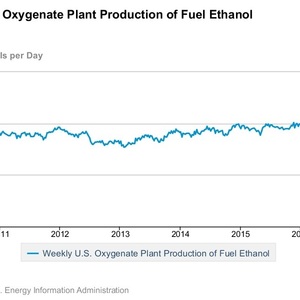US ethanol industry opens 2017 with record-setting production

U.S. Energy Information Administration
January 11, 2017
BY Erin Krueger
The U.S. ethanol industry opened 2017 with a new weekly production record. Production reached an average of 1.049 million barrels per day the week ending Jan. 6, according to data released by the U.S. Energy Information Administration. The new record replaces one set the final week of 2016, when ethanol production reached an average of 1.043 million barrels per day the week ending Dec. 30.
The U.S. ethanol repeatedly broke records for ethanol production in 2016. Prior to Dec. 30, the record was set the week ending Dec. 9, when production averaged 1.04 million barrels per day.
The U.S. ethanol industry has surpassed the 1 million barrel per day mark only 25 times, all since November 2015. Prior to November 2015, the ethanol production record sat at 994,000 barrels per day, which was set the week of June 19, 2015.
Advertisement
Advertisement
Advertisement
Advertisement
Related Stories
The U.S. Energy Information Administration maintained its forecast for 2025 and 2026 biodiesel, renewable diesel and sustainable aviation fuel (SAF) production in its latest Short-Term Energy Outlook, released July 8.
XCF Global Inc. on July 10 shared its strategic plan to invest close to $1 billion in developing a network of SAF production facilities, expanding its U.S. footprint, and advancing its international growth strategy.
U.S. fuel ethanol capacity fell slightly in April, while biodiesel and renewable diesel capacity held steady, according to data released by the U.S. EIA on June 30. Feedstock consumption was down when compared to the previous month.
XCF Global Inc. on July 8 provided a production update on its flagship New Rise Reno facility, underscoring that the plant has successfully produced SAF, renewable diesel, and renewable naphtha during its initial ramp-up.
The USDA’s Risk Management Agency is implementing multiple changes to the Camelina pilot insurance program for the 2026 and succeeding crop years. The changes will expand coverage options and provide greater flexibility for producers.
Upcoming Events










